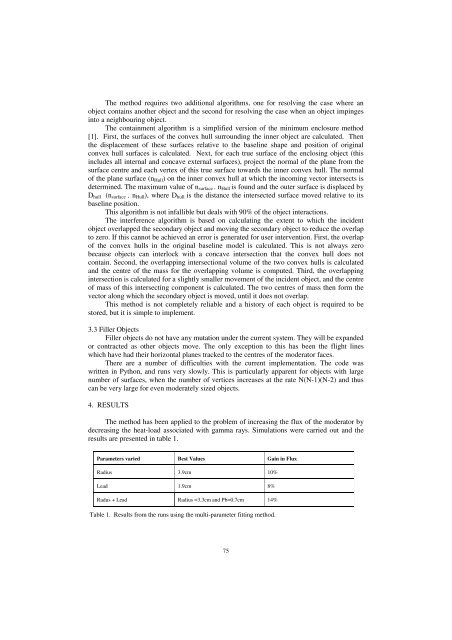Druck-Materie 20b.qxd - JUWEL - Forschungszentrum Jülich
Druck-Materie 20b.qxd - JUWEL - Forschungszentrum Jülich
Druck-Materie 20b.qxd - JUWEL - Forschungszentrum Jülich
Create successful ePaper yourself
Turn your PDF publications into a flip-book with our unique Google optimized e-Paper software.
The method requires two additional algorithms, one for resolving the case where an<br />
object contains another object and the second for resolving the case when an object impinges<br />
into a neighbouring object.<br />
The containment algorithm is a simplified version of the minimum enclosure method<br />
[1]. First, the surfaces of the convex hull surrounding the inner object are calculated. Then<br />
the displacement of these surfaces relative to the baseline shape and position of original<br />
convex hull surfaces is calculated. Next, for each true surface of the enclosing object (this<br />
includes all internal and concave external surfaces), project the normal of the plane from the<br />
surface centre and each vertex of this true surface towards the inner convex hull. The normal<br />
of the plane surface (nHull) on the inner convex hull at which the incoming vector intersects is<br />
determined. The maximum value of nsurface . nHull is found and the outer surface is displaced by<br />
Dhull (nsurface . nHull), where Dhull is the distance the intersected surface moved relative to its<br />
baseline position.<br />
This algorithm is not infallible but deals with 90% of the object interactions.<br />
The interference algorithm is based on calculating the extent to which the incident<br />
object overlapped the secondary object and moving the secondary object to reduce the overlap<br />
to zero. If this cannot be achieved an error is generated for user intervention. First, the overlap<br />
of the convex hulls in the original baseline model is calculated. This is not always zero<br />
because objects can interlock with a concave intersection that the convex hull does not<br />
contain. Second, the overlapping intersectional volume of the two convex hulls is calculated<br />
and the centre of the mass for the overlapping volume is computed. Third, the overlapping<br />
intersection is calculated for a slightly smaller movement of the incident object, and the centre<br />
of mass of this intersecting component is calculated. The two centres of mass then form the<br />
vector along which the secondary object is moved, until it does not overlap.<br />
This method is not completely reliable and a history of each object is required to be<br />
stored, but it is simple to implement.<br />
3.3 Filler Objects<br />
Filler objects do not have any mutation under the current system. They will be expanded<br />
or contracted as other objects move. The only exception to this has been the flight lines<br />
which have had their horizontal planes tracked to the centres of the moderator faces.<br />
There are a number of difficulties with the current implementation. The code was<br />
written in Python, and runs very slowly. This is particularly apparent for objects with large<br />
number of surfaces, when the number of vertices increases at the rate N(N-1)(N-2) and thus<br />
can be very large for even moderately sized objects.<br />
4. RESULTS<br />
The method has been applied to the problem of increasing the flux of the moderator by<br />
decreasing the heat-load associated with gamma rays. Simulations were carried out and the<br />
results are presented in table 1.<br />
Parameters varied Best Values Gain in Flux<br />
Radius 3.9cm 10%<br />
Lead 1.9cm 8%<br />
Radus + Lead Radius =3.3cm and Pb=0.7cm 14%<br />
Table 1. Results from the runs using the multi-parameter fitting method.<br />
75

















